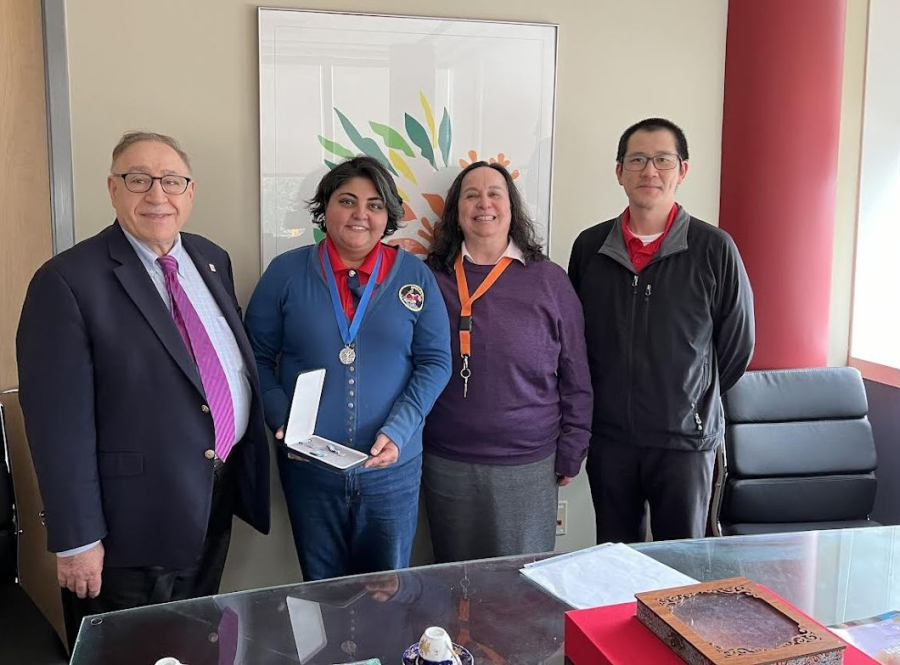A doctoral student at the Cullen College of Engineering has been recognized with a NASA Silver Achievement Medal, for outstanding leadership and innovation of the biomedical and countermeasure hardware selection and flight certification processes.
Kimia Seyedmadani, a biomedical engineering student pursuing her doctorate, received the honor during a ceremony in December. Her advisors are Metin Akay, Founding Chair and John S. Dunn Endowed Chair, and Yasemin Akay, Instructional Associate Professor. Together, they lead the Neural Engineering and Informatics Laboratory in the Biomedical Engineering Department.
The award caught her totally by surprise.
“I was happy and stunned,” she said. “I am an Iranian immigrant with a diverse engineering background, and here I was, receiving one of the highest honor governmental medals, for impact to the field of Bioastronautics. Many people had to nominate me, from my management and above, for me to be recognized. I was very humbled by the support of my family, mentors and, most of all, my team, and I remembered them all, even those who were no longer with us.”
Seyedmadani earned her B.S. followed by her M.S. in Bioengineering and Biomedical Engineering from Arizona State under the guidance of Vincent Pizziconi, an associate professor in the School of Biological and Health Systems Engineering. She also earned her M.S. in Aerospace Engineering and Bioastronautics from the University of Colorado at Boulder under the guidance of James Voss, a former NASA astronaut as well as an AIAA Fellow and Smead Aerospace scholar-in-residence.
Seyedmadani's diverse educational background correlates with the different things asked of her when it comes to her NASA work at the Human Research Program. It is responsible for human exploration, safety, the longevity of crew, and bringing back learned and human research on Earth for increased quality of life.
“I am a spacebiomedical engineer, meaning my work directly translates to the design, development and certification of biomedical and countermeasure hardware for using crew members in space,” she said. “Before my job at NASA, I worked in the medical device and diagnostic industry for 10 years and developed more than 50 medical devices. I am very intrigued by translational research and innovation. Many of my applied research was in that area.”
“NASA recognized me for my ability to translate my previous knowledge to expedite the flight certification process without compromising quality control by augmenting an existing memorandum with the Food and Drug Administration (FDA) and using existing information in the commercial industry. ”
While Seyedmadani had a diversity of knowledge prior to being hired at NASA, she wanted to continue the journey of higher education to be able to transform her work. She chose UH specifically because of Metin and Yasemin Akay’s mentorship and vision.
“I have known them since my undergraduate degree, and I have always appreciated Dr. Metin Akay's interest in innovation, entrepreneurship and increasing healthcare globally,” she said. “I hoped that under their direction, I could continue my work at NASA, continue my independent research, and achieve my doctorate.”
She has conducted research across human subsystems, from musculoskeletal to neuro-cognitive and now at UH neuro-ocular, which she said allowed her to have an appreciation for the human complex adaptability and plasticity across subsystems.
“Space is a frontier, and a unique environment provides a bed to understand the elasticity and plasticity of physiology and anatomy in healthy cohorts,” she said. “I always had the capability to connect the dots and translate information and applications from one field to another. Being a UH Ph.D. candidate in the Neural Engineering and Informatics laboratory combined with NASA Visuomotor Control and Fatigue Countermeasures Laboratory, under Dr. Leland Stone, while my research focuses on oculomotor performance of eye specifically in monocular conditions with implication respect to ophthalmological concerns allows me to gather the tools to enhance my capability and cross boundaries of both science and engineering."
She added, “I also had tremendous mentorship at NASA Johnson Space Center, from my management, the Research Operation Integration group, and specifically the chief engineer, Mr. Keith Tucker. He allowed me to conduct my Ph.D. research in bioastronautics under the biomedical engineering flagship in NASA facilities with collaboration of the UH Biomedical Department.”
Seyedmadani also added that creativity and inspiration come from anywhere and from anyone, for those who seek knowledge. She considers a key for her success to be perseverance and hard work. Therefore, she encourages everyone to "Never, Ever Give Up!"
![Kimia Seyedmadani [center], a biomedical engineering student pursuing her doctorate, received the NASA Silver Achievement award during a ceremony in December. She is flanked by [left] Dr. Katayoun Madani, Global Surgery Policy and Advocacy Baker Institute Fellow and clinical instructor of global surgery at Baylor College of Medicine; and [right] Michelle Fireling, Director of Human and Health Performance at NASA. Kimia Seyedmadani [center], a biomedical engineering student pursuing her doctorate, received the NASA Silver Achievement award during a ceremony in December. She is flanked by [left] Dr. Katayoun Madani, Global Surgery Policy and Advocacy Baker Institute Fellow and clinical instructor of global surgery at Baylor College of Medicine; and [right] Michelle Fireling, Director of Human and Health Performance at NASA.](/sites/ccoe.egr.uh.edu/files/images/news/2024/kimia-award-picture-border-01.jpg)
